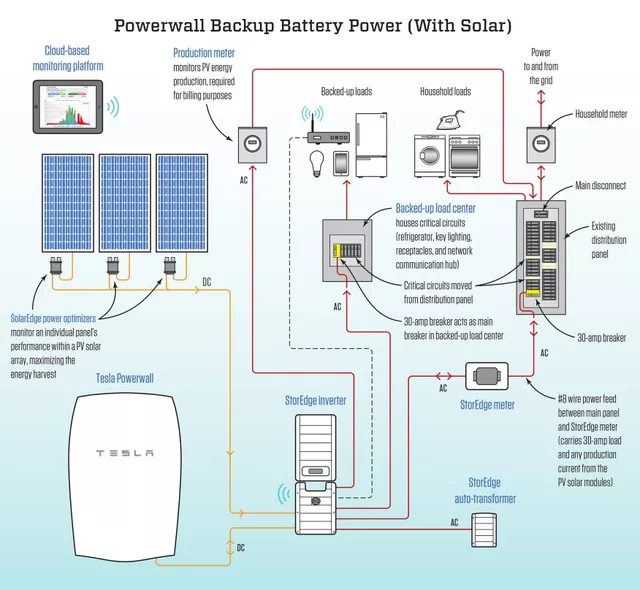Researching Energy Storage Systems
It takes a lot of time to study energy storage systems, and there are many ongoing topics to sort out, including technology, market, and future needs.
Today, we will focus on discussing Tesla’s personal energy storage system Powerwall. Overall, Tesla’s Powerwall energy storage system has had a huge impact on the solar energy field, promoting home energy storage as a mainstream option.
Note: Looking at Tesla’s product line, there are some things that can be compared with Apple’s product line.
History and Specifications of Powerwall

Tesla released the first generation Powerwall, an integrated energy storage system with a battery capacity of 6.4kWh, which is not a large capacity.
The second generation Powerwall 2 increased its storage capacity by more than double and includes an integrated battery charger.
In May 2021, Tesla updated this product to Powerwall+ (plus). The system itself has not changed, but the solar inverter was integrated from the Powerwall 2 battery system, making it a complete all-in-one solar storage system.
Below are the system’s parameters, and I have done some preliminary sorting and comparison:




The biggest changes from the first generation to the second generation are:
- Battery capacity doubling
- Integrated battery charger
(1) The Tesla Powerwall 2 also adopted a complete liquid cooling system for thermal management of home energy storage systems. It employs a fully sealed liquid cooling system (including 2.3 liters of liquid coolant), which actually has the possibility of operating at higher temperatures and increasing overall cycle counts. This thermal management system is similar to the one used in cars and can perform both heating and cooling functions.
(2) From a system perspective, the assembly of Powerwall 1 was quite complicated. Initially, Tesla wanted to create a networked system, so some systematic updates were made from Powerwall 1 to Powerwall 2 at the gateway level.

(3) At the same time as the Powerwall 2 update, a solar inverter with liquid cooling thermal management was released, available in two sizes: 3.8kW and 7.6kW. It integrates all safety features, including rapid shutdown, arc fault, and ground fault protection.

The third generation of Powerwall+, which made some subtle adjustments to the available capacity and weight, mainly updates the Tesla solar inverter that comes with system integration to become a complete all-in-one system. The storage capacity remains unchanged at 13.5kWh, while the rated power has increased significantly to meet off-grid and backup use. The rated power has been raised from 5kW (continuous) and 7kW (peak) to 7kW (continuous) and 10kW (peak) in off-grid mode. The grid-tied rated power has also increased slightly to 5.8kW (continuous) and 7.8kW (peak). The specifications of the integrated solar inverter are basically unchanged, but from a design perspective, it has been readjusted.
Powerwall Composition
As mentioned before, Powerwall 1 used 18650 batteries, while Powerwall after that used 21700. The overall system is equipped with a charge and AC/DC inverter that can be compatible with both DC and AC connections.
 The CTC system is actually compatible with the previous Power Pack. The first generation was designed with built-in modules, which actually used two 18650 batteries arranged in parallel like the Model S module. In the battery system, the water-cooled pipes run along both sides of the box. The electronic parts, including the converter and BMS, are arranged in the front compartment. The new design on the right cancels the water-cooling plan at the system level and directly puts the batteries together and adheres them together as a whole. From the tags, it appears that a 900V system is being used, with a large number of battery cells sealed with thick glue.
The CTC system is actually compatible with the previous Power Pack. The first generation was designed with built-in modules, which actually used two 18650 batteries arranged in parallel like the Model S module. In the battery system, the water-cooled pipes run along both sides of the box. The electronic parts, including the converter and BMS, are arranged in the front compartment. The new design on the right cancels the water-cooling plan at the system level and directly puts the batteries together and adheres them together as a whole. From the tags, it appears that a 900V system is being used, with a large number of battery cells sealed with thick glue.

In summary, I am looking forward to Tesla using China’s lithium iron phosphate scheme for this system in the future. By then, the overall price may see a significant decrease. From the perspective of continuous product strategy tracking, Tesla has the ability to playfully integrate in all aspects.
This article is a translation by ChatGPT of a Chinese report from 42HOW. If you have any questions about it, please email bd@42how.com.